Front Disc Brake Pads Replacement With RPO LNF
Warning: Refer to Brake Dust Warning in the Preface section.
Removal Procedure
- Inspect the fluid level in the brake master cylinder reservoir.
- If the brake fluid level is midway between the maximum-full point and the minimum allowable level, no brake fluid needs to be removed from the reservoir before proceeding.
- If the brake fluid level is higher than midway between the maximum-full point and the minimum allowable level, remove brake fluid to the midway point before proceeding.
- Raise and support the vehicle. Refer to Lifting and Jacking the Vehicle.
- Remove the tire and wheel assembly. Refer to Tire and Wheel Removal and Installation.
- Holding the lower end of the retainer (1) down and using a hammer and punch carefully tap the lower caliper guide pin (2) inward out of the caliper.
- Carefully rotate the brake pad retainer (1) upward.
- Remove the brake pad retainer (1).
- Using a hammer and punch carefully tap the upper caliper to brake pad mounting pin (2) inward out of the caliper.
- Using a disc brake pad spreader, apply pressure to the brake pad backing plates until the caliper pistons are fully compressed into the caliper piston bores.
- Remove the brake pads (1) from the caliper.
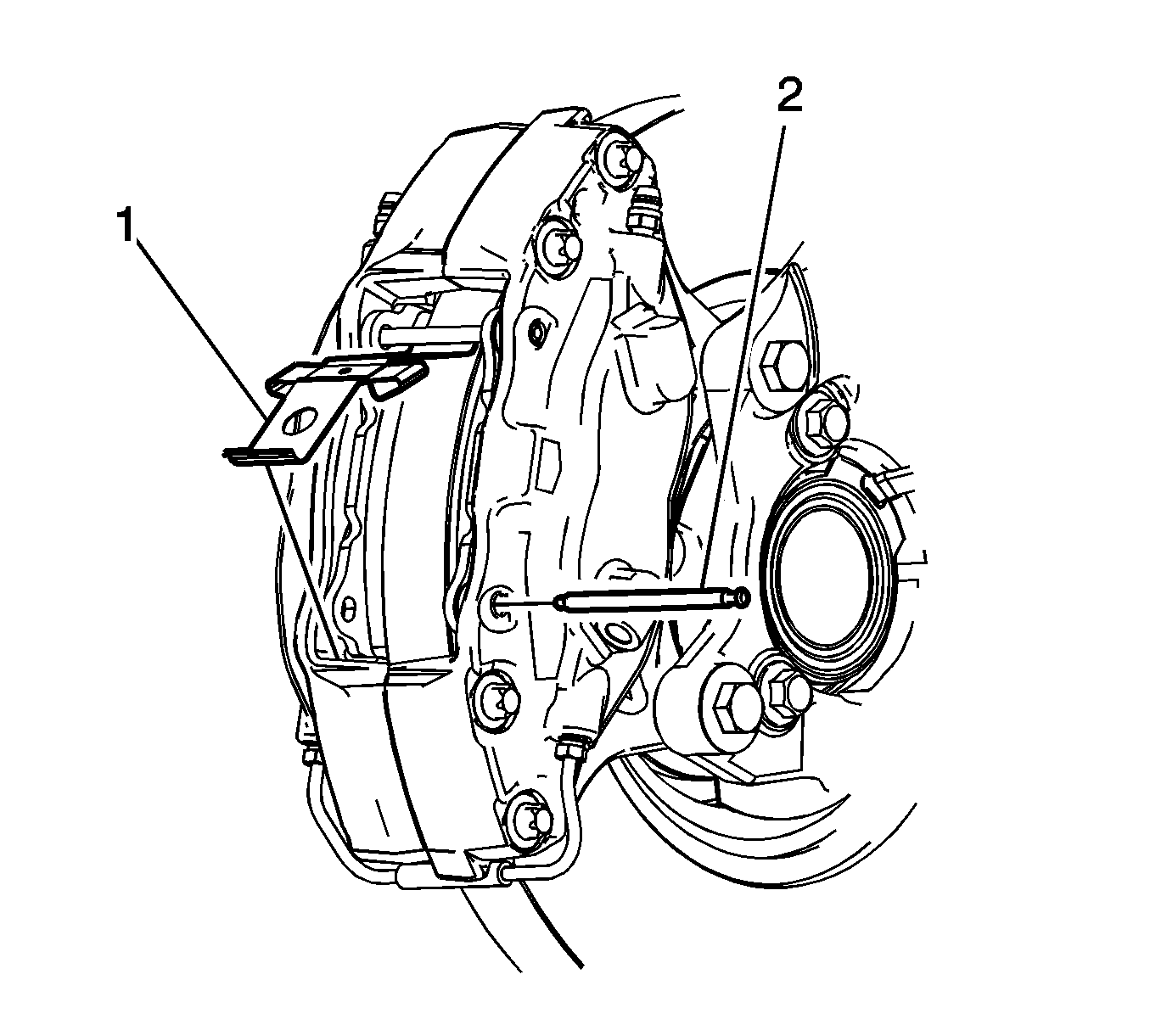

Installation Procedure
- Inspect the brake caliper guide pins. If damaged, or corroded replace the guide pin. Do not attempt to clean away any corrosion.
- Inspect the brake caliper piston boot for damage and/or deterioration, replace if damaged or deteriorated. Refer to Front Brake Caliper Overhaul.
- Install the brake pads (1) to the caliper.
- Install the upper caliper guide pin (2) through the caliper, inner and outer brake pads.
- Using a hammer and punch, carefully seat the upper guide pin (2) to the outer caliper half. Ensure the caliper guide pin is seated into the outer caliper pin seat.
- Install the brake pad retainer (1) under the upper caliper pin assembly.
- Rotate brake pad retainer (1) down.
- Carefully apply pressure downward on the lower end of the brake pad retainer.
- Carefully install the lower caliper guide pin (2) through the caliper, inner and outer brake pads.
- Using a hammer and punch carefully seat the upper guide pin (2) to the outer caliper half. Ensure the caliper guide pin is seated into the outer caliper pin seat. Ensure the brake pad retainer is centered and retaining both brake pads.
- Install the tire and wheel assembly. Refer to Tire and Wheel Removal and Installation.
- Lower the vehicle.
- With the engine OFF, gradually apply the brake pedal to approximately 2/3 of its travel distance.
- Slowly release the brake pedal.
- Wait 15 seconds, then repeat steps 13 and 14 until a firm brake pedal apply is obtained; this will properly seat the brake caliper pistons and brake pads.
- Fill the brake master cylinder reservoir to the proper level. Refer to Master Cylinder Reservoir Filling.
- Burnish the pads and rotors. Refer to Brake Pad and Rotor Burnishing.


Front Disc Brake Pads Replacement Without RPO LNF
Warning: Refer to Brake Dust Warning in the Preface section.
Removal Procedure
- Inspect the fluid level in the brake master cylinder auxiliary reservoir.
- If the brake fluid level is midway between the maximum-full point and the minimum allowable level, no brake fluid needs to be removed from the reservoir before proceeding.
- If the brake fluid level is higher than midway between the maximum-full point and the minimum allowable level, remove brake fluid to the midway point before proceeding.
- Raise and support the vehicle. Refer to Lifting and Jacking the Vehicle.
- Remove the tire and wheel assembly. Refer to Tire and Wheel Removal and Installation.
- Install and firmly hand tighten 2 wheel nuts to opposite wheel studs in order to retain the rotor to the hub.
- Install a large C-clamp (1) over the body of the brake caliper (2) with the C-clamp ends against the rear of the caliper body and against the outboard brake pad.
- Tighten the C-clamp evenly until the caliper piston is compressed into the caliper bore enough to allow the caliper to slide past the brake rotor.
- Remove the C-clamp from the caliper.
- Remove the brake caliper lower guide pin bolt (1).
- Without disconnecting the hydraulic brake flexible hose, pivot the caliper upward and secure the caliper with heavy mechanics wire (1), or equivalent.
- Remove the brake pads from the caliper mounting bracket.
- Remove the brake pad retainers (1) from the caliper bracket.
- Thoroughly clean the brake pad hardware mating surfaces of the caliper bracket (2) of any debris and corrosion.
- Inspect the brake caliper guide pins for freedom of movement and inspect the condition of the guide pin boots. Move the guide pins inboard and outboard within the bracket bores, without disengaging the slides from the boots, and observe for the following:
- If any of the conditions listed are found, the brake caliper guide pins and/or boots require replacement.
- Install a large C-clamp (1) over the body of the brake caliper (3), with the C-clamp ends against the rear of the caliper body and against an old inboard brake pad (2) or a wood block installed against the caliper piston.
- Tighten the C-clamp (1) evenly until the caliper piston is compressed completely into the caliper bore.
- Remove the C-clamp and the old brake pad or wood block from the caliper.
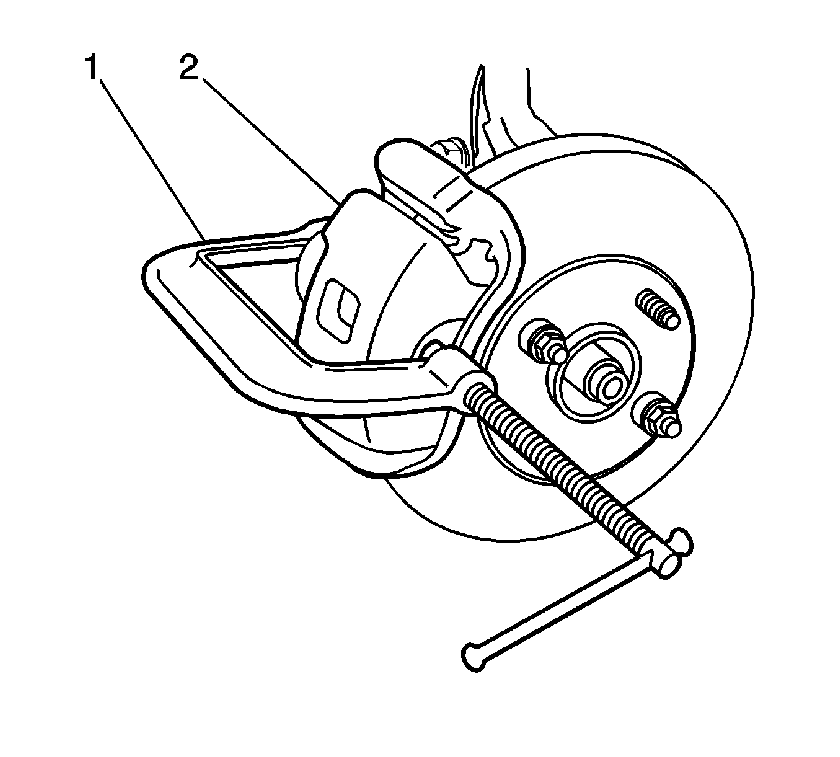
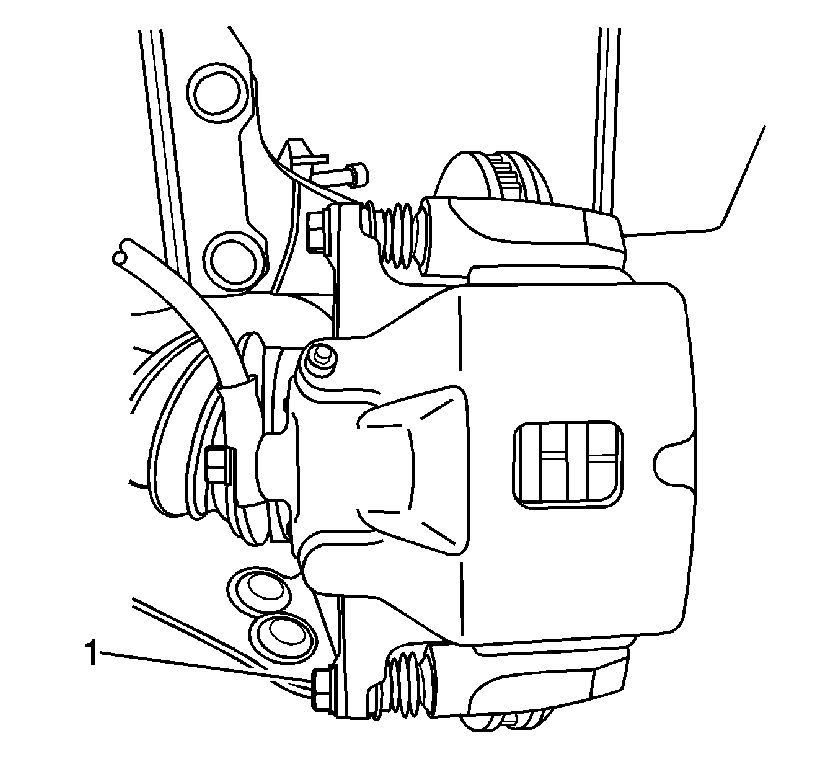
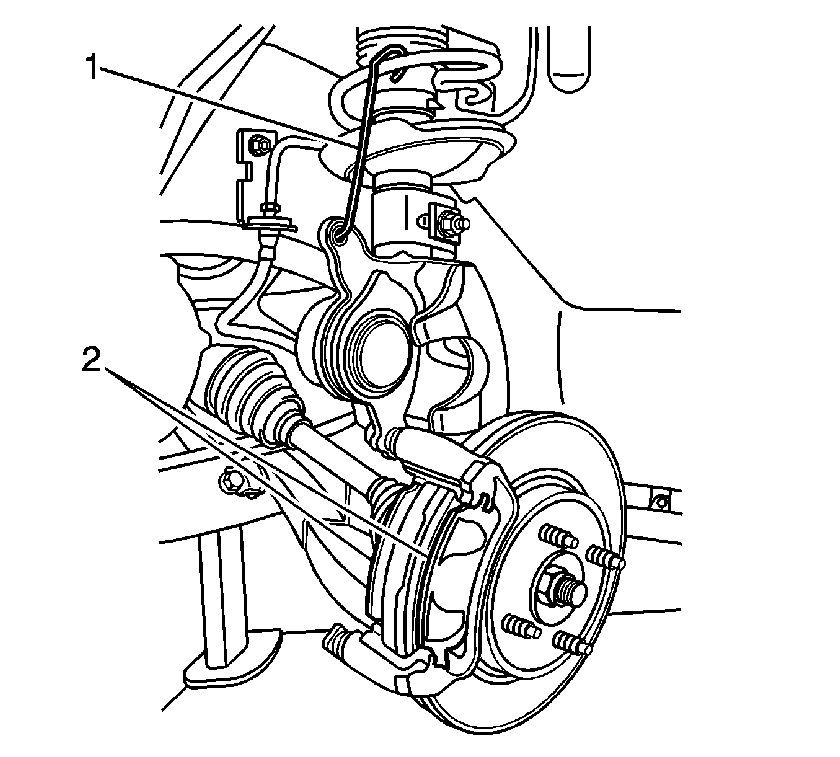
Caution: Support the brake caliper with heavy mechanic wire, or equivalent, whenever it is separated from its mount and the hydraulic flexible brake hose is still connected. Failure to support the caliper in this manner will cause the flexible brake hose to bear the weight of the caliper, which may cause damage to the brake hose and in turn may cause a brake fluid leak.
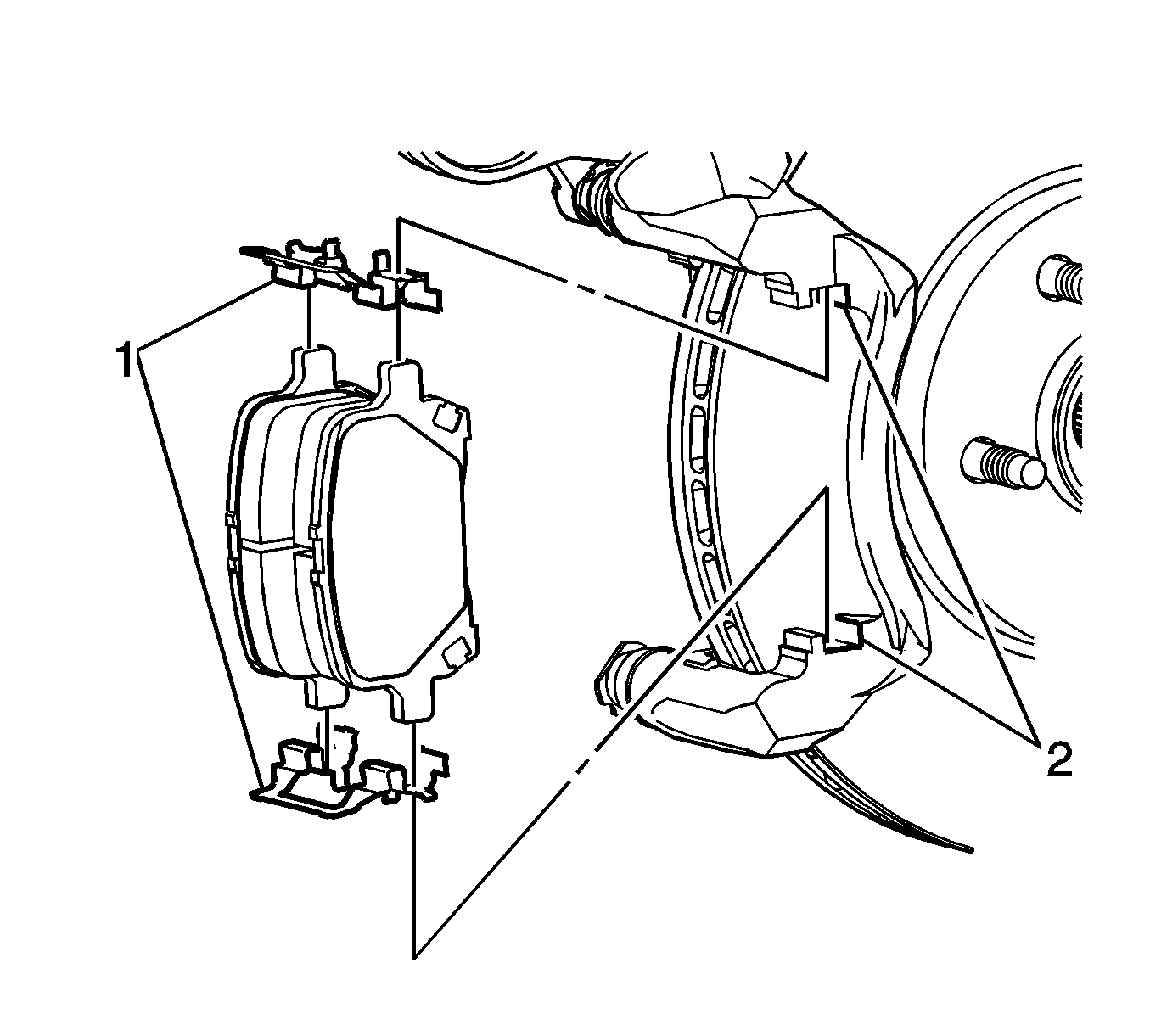
| • | Restricted caliper guide pin movement |
| • | Looseness in the brake caliper mounting bracket |
| • | Seized or binding caliper guide pins |
| • | Split or torn boots |

Installation Procedure
- Apply a very thin coating of high temperature silicone brake lubricant to the pad hardware mating surfaces of the caliper bracket (2) only.
- Install the brake pad retainers (1) to the brake caliper bracket.
- Install the brake pads to the caliper bracket.
- Remove the support, and rotate the brake caliper into position over the disc brake pads and to the caliper mounting bracket.
- Install the lower brake caliper guide pin bolt (1).
- Remove the wheel nuts retaining the brake rotor to the hub.
- Install the tire and wheel assembly. Refer to Tire and Wheel Removal and Installation.
- Lower the vehicle.
- With the engine OFF, gradually apply the brake pedal approximately 2/3 of its travel distance.
- Slowly release the brake pedal.
- Wait 15 seconds, then gradually apply the brake pedal approximately 2/3 of its travel distance again until a firm brake pedal apply is obtained. This will properly seat the brake caliper pistons and brake pads.
- Fill the master cylinder auxiliary reservoir to the proper level. Refer to Master Cylinder Reservoir Filling.
- Burnish the pads and rotors. Refer to Brake Pad and Rotor Burnishing.

Note: The wear sensor equipped disc brake pad must be mounted inboard of the rotor with the leading edge of the sensor facing the brake rotor during forward wheel rotation, or at the top of the pad when installed in vehicle position.
Caution: Refer to Fastener Caution in the Preface section.

Tighten
Tighten the bolt to 34 N·m (25 lb ft).
